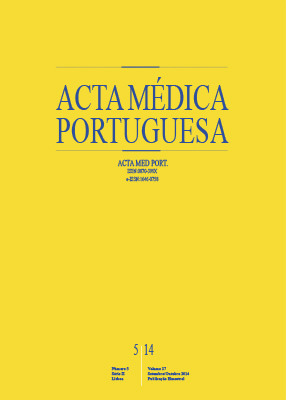Acute Gastroenteritis by Cambylobacter Spp: a Retrospective Study of a Paediatric Emergency Department
DOI:
https://doi.org/10.20344/amp.5122Abstract
Introduction: Infection by Cambylobacter occurs worldwide and represents the main cause of acute bacterial gastroenteritis within the European Union.
Aims: Determine the prevalence of Campylobacter in stool cultures from patients with gastroenteritis and study their microbiological, epidemiological, clinical, and therapeutic profiles, as well as associated complications.
Material and Methods: Review of clinical files of patients presenting to the paediatric emergency department of a general district hospital over a 30 month period with an acute gastroenteritis and a Campylobacter isolated in a stool specimen.
Results: Out of 216 stool cultures, 98 (45%) were positive. We identified Campylobacter in 49 (50%) cases; 30 (61%) were female. Median age was 23 months. Fourteen patients were under one year of age, 25 between one and five years old and 10 patients were over five years old. Watery diarrhea was identified in 5 (10%) patients, bloody diarrhea in 44 (90%) and mucosanguineous in 14 (29%), while 23 (47%) had fever, 14 (29%) complained of abdominal pain and 11 (22%) presented with vomiting. One patient was septic. Five patients were admitted as inpatients. Eight patients were treated with azithromycin.
Discussion: This is the largest published national series on gastroenteritis by Campylobacter in children and the first in the south region. Campylobacter was the main bacteria isolated. Infection was self-resolving in the majority of cases. Nevertheless, severe forms of this infection should be considered. Increased resistance to quinolones is worrisome.
Conclusion: Judicious use of stool cultures allows etiological identification of bacterial gastroenteritis. The increase in Campylobacter cases reinforces the need for better control of hygiene measures in handling food products.
Keywords: Campylobacter; Child; Gastroenteritis; Campylobacter Infections; Emergency Service, Hospital; Portugal.
Downloads
Downloads
Published
How to Cite
Issue
Section
License
All the articles published in the AMP are open access and comply with the requirements of funding agencies or academic institutions. The AMP is governed by the terms of the Creative Commons ‘Attribution – Non-Commercial Use - (CC-BY-NC)’ license, regarding the use by third parties.
It is the author’s responsibility to obtain approval for the reproduction of figures, tables, etc. from other publications.
Upon acceptance of an article for publication, the authors will be asked to complete the ICMJE “Copyright Liability and Copyright Sharing Statement “(http://www.actamedicaportuguesa.com/info/AMP-NormasPublicacao.pdf) and the “Declaration of Potential Conflicts of Interest” (http:// www.icmje.org/conflicts-of-interest). An e-mail will be sent to the corresponding author to acknowledge receipt of the manuscript.
After publication, the authors are authorised to make their articles available in repositories of their institutions of origin, as long as they always mention where they were published and according to the Creative Commons license.









